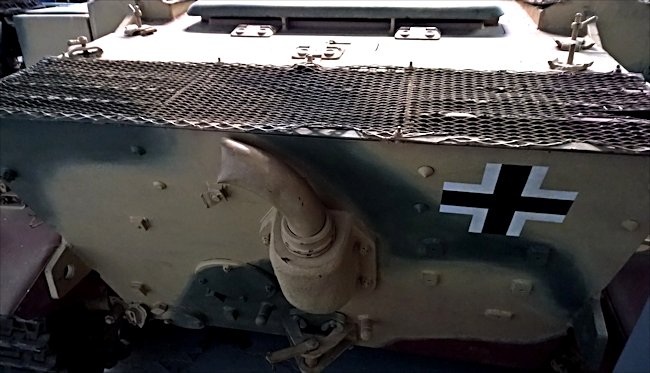Panzer II Ausf. L Lynx
This German Panzerspähwagen II Ausf. L Luchs Light Tank (Sd.Kfz. 123) can be found at the Tank Museum, Bovington, Dorset, England Valley. Luchs is the German word for a Lynx, a medium sized ferocious wild-cat.

German Panzer II Luchs Light tank (PzKpfw II Ausf. L Sd.Kfz. 123) at the Tank Museum, Bovington, Dorset, England
It is a very rare tank. Out of the 104 built between September 1943 to January 1944 only two survive. This one in Bovington and the other in the French Tank Museum in Saumur, France. A group of Americans are building one from salvaged parts. You can watch their progress at http://panzerfabrik.net
The Luchs or Lynx light reconnaissance tank was designed for use on the Russian front but also saw action in Normandy and the battle for Germany on the Western Front. It evolved from a series of light tracked reconnaissance vehicles for use in Panzer Divisions. It was based on the Panzer II tank but had a larger chassis, thicker armour and a new torsion bar suspension system. It had new overlapping larger wheels like those fitted to the Panther and Tiger tanks

Panzer II Ausf. L turret is fitted with a 20mm cannon and a coaxial machine gun
It had a good power to weight ratio. Combine this with a low ground pressure, the result is a vehicle that could produce above average cross-country proformance. The Panzer II 20mm gun was not upgraded. This was planed for a new tank to be called the Leopard that was never built. It was going to have a turret that could support a 50mm gun.
The Panzer II Ausf. L Luchs at the Tank Museum in Bovington belonged to the 1st Company of the Armoured Reconnaissance Unit of the 9th Panzer Division. (1. Kompanie, Panzer Aufklarung Abteilung, 9. Panzer Division). They had 26 Luchs tanks on the 1st July 1944. After fighting in Normandy the 9th Panzer retreated to Aachen and finally surrendered in the Ruhr in 1945.

Side view of the Panzer II Lynx Light tank
This tank had a crew of four: Commander, Gunner, Driver and radio operator. One more than the previous versions of the Panzer II light tank. It had 30mm of armour on the front and had a top road speed of 37mph (60km/h) It weighed around 13 tons. It was armed with a 20mm KwK 38 L55 cannon and could carry 330 rounds. A fuel-tank capacity of 235 liters gave the Luchs had a road-range of about 290km.

Rear exhaust on the back of a Panzer II Luchs Light tank
The Panzerspaehwagen II Ausf L Luchs was manufactured by MAN and Henschel (small number) from September of 1943 to January of 1944. It is believed that only 104 came off the production line. Some Luchs tanks on the Eastern front were upgraded on the battlefield with the addition of extra frontal armour plating.
The crew used an intervcom system to communicate with each other. The vehicle was fitted with the latest tank radio: a FuG12 MW receiver and 80-watt transmitter. This gave it a better radio range on the battlefield.

Tank crew escape hatch on the rear of a Panzer II Luchs turret
Where can I find other preserved Panzer II Tanks?
- Pz Kpfw II Ausf. C - Musée des Blindés, Saumur, France
- Pz Kpfw II Ausf. C - Kalemegdan Military Museum, Belgrade Serbia
- Pz Kpfw II Ausf. C - Military Historical Museum, Lenino-Snegiri, Russia
- Pz Kpfw II Ausf. C - Canadian War Museum, Ottawa, Canada
- Pz Kpfw II Ausf. C - Wreck, Andre Becker Collection, Belgium
- Pz Kpfw II Ausf. F - Bovington Tank Museum England
- Pz Kpfw II Ausf. F - Kubinka Tank Museum, Russia
- Pz Kpfw II Ausf. F - National Armor and Cavalry Museum, Fort Benning, GA, USA
- Pz Kpfw II Ausf. F - Westwall Museum, Pirmasens, Germany
- Pz Kpfw II Ausf. L "Luchs"- Bovington Tank Museum England
- Pz Kpfw II Ausf. L "Luchs"- Musée des Blindés, French Tank Museum Saumur, France
- Pz Kpfw II Ausf. L "Luchs" Replica - Private collection, America
- Source - Pierre-Oliver Buan - http://the.shadock.free.fr/Surviving_Panzers.html
WW2 Tank Books

